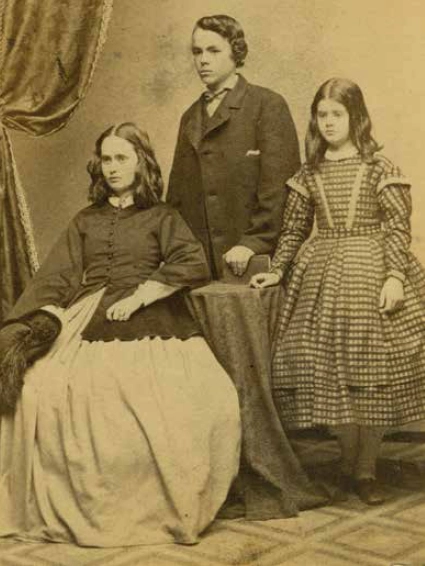He was, in Alcott’s estimation, “a worthy boy full of pictures, fishing rods and fun.”57 In his adolescent eagerness, Julian promptly developed a crush on May. In his credulity, he soon became an irresistible target for Alcott’s foolery. Julian never forgot how she and May once alerted him to the expected arrival of a handsome English relation and how, on April 1, the slender, mustachioed stranger arrived. The Englishman slipped his arm around May’s waist and drove Julian into mute fury by calling him “my dear child.” As Julian’s fists clenched and his face turned crimson, the stranger snatched off his black felt hat, and a mass of black hair fell down to his waist. He was none other than Louisa herself, who dashed away shouting, “April fool!” Though Alcott herself denied it, Julian, at least, later believed that Alcott had chosen him, and no other, as the basis for Laurie.58

Around 1859, Nathaniel Hawthorne’s three children, Una, Julian, and Rose, posed for this group photograph. Julian, a favorite of Alcott’s and the bemused victim of some of her practical jokes, claimed to have been another of the models for Laurie. (Louisa May Alcott Memorial Association)
In Little Women, the Civil War stands at a distance. Though it temporarily robs the March sisters of their father and, for a time, threatens to take him away forever, the war never confronts any of the girls in Alcott’s fiction in all of its immediate, blood-soaked horror. Alcott herself did not enjoy the luxury of that distance. When the war erupted in 1861, Bronson Alcott was in his sixties. Unlike Mr. March, who is a chaplain in the Army of the Potomac, the elder Alcott did not serve. The Alcott who went to war was Louisa herself. As soon as she turned thirty in November 1862 and thereby became eligible for service, she applied for an appointment as a military nurse.
Days later, her orders came through. Alcott was ordered to the Union Hotel Hospital in Georgetown in the District of Columbia. She had been there only a day or two before the hospital admitted a tide of wounded men, freshly evacuated from the catastrophe known as the Battle of Fredericksburg. Working to exhaustion, Alcott cleaned and dressed wounds, wrote letters for patients who could not write, and read Dickens to those eager for some diversion from their loneliness and pain. The hospital was, in Alcott’s words, a “pestilence-box.”59 The appalling lack of sanitation, coupled with her merciless work schedule, took a prompt and horrible toll. Alcott collapsed, a victim of typhoid pneumonia. In Concord, Bronson and Abba received a telegram. The hospital matron, herself dying of the same disease, urged them to come at once. So it was that, as in Little Women, a distraught parent rode south to rescue a family member from the ravages of war. But it was Bronson, not Marmee, who made the journey, and it was Louisa, not the family patriarch, whose life was to be saved. For three weeks, Alcott lay in a delirium, besieged by bizarre hallucinations. But her father had come just fast enough; she survived.
Both in real life and in fiction the episode of illness and rescue cost the second eldest daughter her hair. In Part First, Chapter XV of Little Women, Jo March famously sells her hair to help finance Marmee’s errand of mercy; less well known is the fact that Alcott’s doctors shaved her scalp as part of the effort to save her life. In her journal, Alcott mourned the loss of her “one beauty,” a lament she was to repeat in Little Women. But she added philosophically, “Never mind, it might have been my head & a wig outside is better than a loss of wits inside.”60
It was during this illness as well that Alcott received her calamitous, nearly fatal exposure to calomel. The mercury ravaged her gums and damaged her nerves. For decades afterward, bouts of pain came and went almost randomly, and Alcott was often forced to write in grim defiance of her discomfort.
1 comment